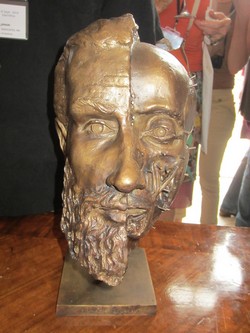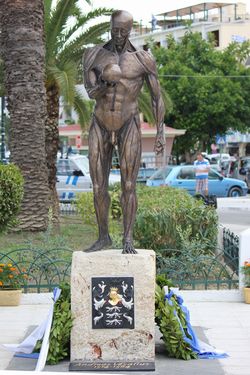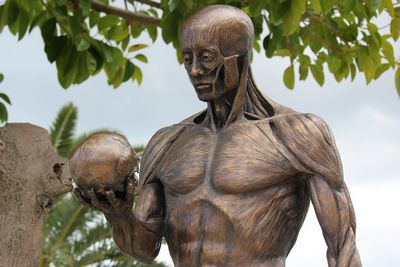Continued from "The presence of Andreas Vesalius in Zakynthos (2)"
Bust of Vesalius made by Pascale Pollier
Bust of Vesalius made by Pascale Pollier
According to Theo Dirix, Belgian Consul to Greece and Vesalius enthusiast, there are other reminders on the island such as a painting in one of the local schools.
On September 3rd, 2014, as part of the Vesalius Continuum meeting on Zakynthos Island, a new bronze statue was unveiled to celebrate the life and works of Andrea Vesalius and remember his death on Zakynthos. This statue is a representation of Vesalius’ style of depicting anatomy in his book “De Humani Corporis Fabrica Libri Septem” and is a “muscle man” mixed with the motif of the famous plate 20 of Book 1 that shows a skeleton musing over a skull. The statue also presents the Vesalius family coat of arms. The statue is the work of Richard Neave and Pascalle Pollier.
Pascale Pollier, a biomedical artist specializes in face reconstructions and made a new bust of Vesalius based on the only known portrait of the great anatomist found on the pages of his immortal book “The Humani Corporis Fabrica Libri Septem”.
The statue was unveiled in front of an international crowd of anatomists, medical historians, biomedical artists, and film makers. Following the ceremony a display of artistic works related to Vesalius was opened in the Zakynthos municipality.
These are today the signs of the presence of Vesalius on Zakynthos. We know today that his body is interred in the cemetery of the church of Santa Maria della Grazie in Zakynthos. Sadly this church was destroyed twice in earthquakes and in 1953 was completely demolished along with 85% of the city. It was not rebuilt and now lies under the new, rebuilt city. One of the research papers presented at the 2014 Vesalius Continuum meeting has rediscovered the location of the church with great accuracy. The account of this paper and how I was able to find this geolocation will be presented in another article.
In 2014 the Vesalius Continuum Meeting with the Zakynthos government helped unveil a bronze statue to honor Andreas Vesalius. The statue reminds us of the "philosopher" of Jan Stephan Van Calcar, but in this case it is a muscle man contemplating a skull. At the base of the statue is the Vesalian coat of arms with the three weasels
New bronze statue of Vesalius
Close up of the new bronze statue of Vesalius
Sources
1. “Andreas Vesalius of Brussels 1514-1564” O’Malley, CD. Los Angeles 1965
2. "Andreas Vesalius; The Making, the Madman, and the Myth" Joffe, SN. Persona Publishing 2009
3. “In Search of Andreas Vesalius – The Quest for the Lost Grave” Dirix, T. Lanoo Campus Belgium 2014






